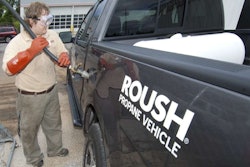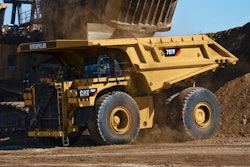
 The 250,000 John Deere backhoe is the 310SK pictured. It was presented to NPL Construction who primarily buys its equipment from Deere.
The 250,000 John Deere backhoe is the 310SK pictured. It was presented to NPL Construction who primarily buys its equipment from Deere.Licensed in 37 states, energy distribution contractor NPL Construction says it takes a strategic sourcing approach to the equipment suppliers for its 5,500-unit fleet: They have several partnerships and high expectations.
“We tend to have one of the newest fleets in our industry,” says Jim Connell, director of business development/strategic partnerships for the Phoenix, Arizona-based firm, which had about $600 million in annual revenues in 2012. “Our philosophy is to maximize the first life of the equipment. For instance, we have a four- to five-year replacement cycle on our backhoes. We buy them effectively, have low owning and operating costs and get good resale value when we’re through with them, using a variety of disposal options, including auctions and private sales.”
For their $300 million-replacement-value fleet, that also means buying backhoes, compact excavators and other construction equipment primarily from one source: John Deere. NPL also outsources most of their maintenance to Deere dealers across the country.
This keep-it-current approach also gives the company a leg up in environmentally-challenged areas, and with clients who have green initiatives, Connell says. “The newness of our fleet has really been a differentiator in a couple of recent jobs,” he says.
And the telematics that come with a newer fleet has allowed NPL to “really dial it in” on essential cost control information, such as failures and downtime, Connell says.
“With all Deere backhoes now standard with JDLink, we’re really on the cusp on tapping into an immense amount of data so that we can give operations the best information on what’s going on with the fleet,” he says. “We’ve never been able to do that before. It gives us the opportunity to use our assets more efficiently, because they’re not getting cheaper.”
Since most of NPL’s fleet is just now making the transition from Tier 3 to Tier 4 Interim, the company has experienced few concerns with the advances in emissions technology. Connell cautions, however, “it will be a different discussion when we go into Tier 4 Final because we have concerns about the quality of diesel we would be putting into these machines.”
Meeting NPL’s equipment sourcing demands can have its challenges, according to Jim Kane, NPL president and CEO. In 2010, new pipeline replacement rules “resulted in virtual doubling of our workload,” Kane said in remarks made during the presentation of Deere’s 250,000th backhoe to NPL in late February.
In short, the company needed 75 backhoes in 60 days. “We know you just don’t walk into Walmart and buy a backhoe,” said Kane. “Deere went out of the way to meet our needs in the most extraordinary of ways.”
NPL and Deere have also worked closely on several safety initiatives, including what the company calls “red zone training,” which outlines the process for making sure that workers stay out of the backhoe’s swing arc. The two also collaborated to develop a harness system to safely move road plates.
“Having access to Deere’s online product configurator has been a big help in getting the right machine to the right place at the right time,” says Todd Davisson, senior capital equipment buyer.
NPL also owns a number of compact excavators, which the company employs in more confined urban spaces, work the company has seen expand in the past four years as the gas distribution industry began to emphasize replacement pipelines over new pipelines.
But the backhoe is still the backbone of NPL’s fleet, says Kane. “We’re still digging 12- to 14-foot ditches.”
In the video below, Davisson and Connell go further into NPL’s equipment strategy.
[youtube l7VZJHIroh4 nolink]












